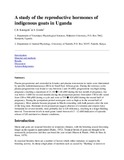| dc.contributor.author | Katongole, CB | |
| dc.contributor.author | Gombe, S | |
| dc.date.accessioned | 2013-08-05T11:42:02Z | |
| dc.date.available | 2013-08-05T11:42:02Z | |
| dc.date.issued | 1985-09 | |
| dc.identifier.citation | Katongole, C. B., & Gombe, S. (1985, September). A study of the reproductive hormones of indigenous goats in Uganda. In Conference on Small Ruminants in African Agriculture. Addis Ababa, Ethiopia 30 Sep to 4 Oct 1985 (pp. 2-11). | en |
| dc.identifier.uri | http://www.ilri.cgiar.org/InfoServ/Webpub/fulldocs/X5464B/x5464b02.htm | |
| dc.identifier.uri | http://hdl.handle.net/11295/54408 | |
| dc.description.abstract | Plasma progesterone and oestradiol in females and plasma testosterone in males were determined by specific radioimmunoassays (RIA) in Small East African goats. During the oestrous cycles plasma progesterone was found to vary between 2 and 18 nM/l, progesterone was high during pregnancy reaching a maximum of 21.10 � 1.46 nM/l during the last month of pregnancy, but was below 3 nM/l for several months during the postpartum period. Oestradiol-17B levels varied from 120 to 900 pM/l during a cycle and were at 554 � 424 pM/l during the second half of pregnancy. During the postpartum period oestrogens were as high as in the second half of pregnancy. Most animals became pregnant in March coinciding with lush pastures after the start of the long rains. Hormone levels postpartum suggest absence of ovulation and corpora lutea formation for several months, most probably due to LH deficiency, resulting in a longer kidding interval. Testosterone levels in male goats varied between 0.5 - 12 nM/l indicative of episodic release of LH unrelated to climatic conditions. | en |
| dc.language.iso | en | en |
| dc.publisher | University of Nairobi, | en |
| dc.title | A study of the reproductive hormones of indigenous goats in Uganda | en |
| dc.type | Technical Report | en |
| local.publisher | Department of Animal Physiology | en |

